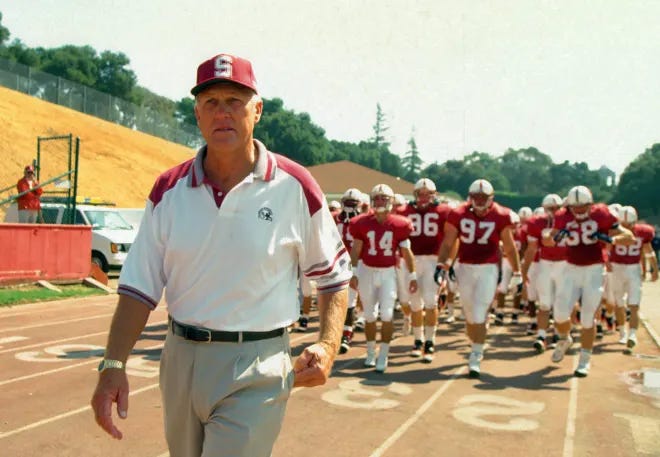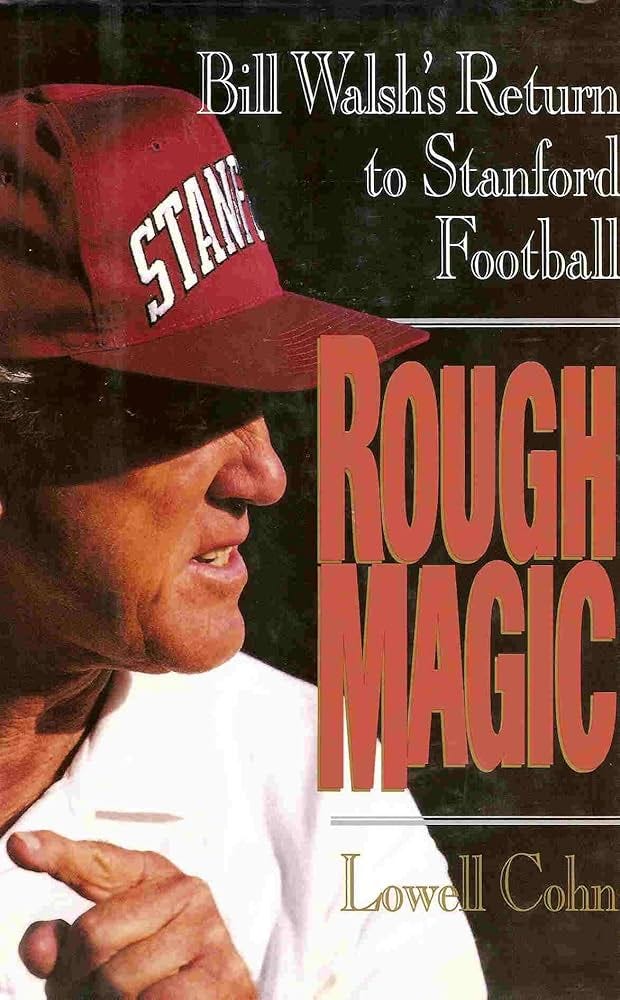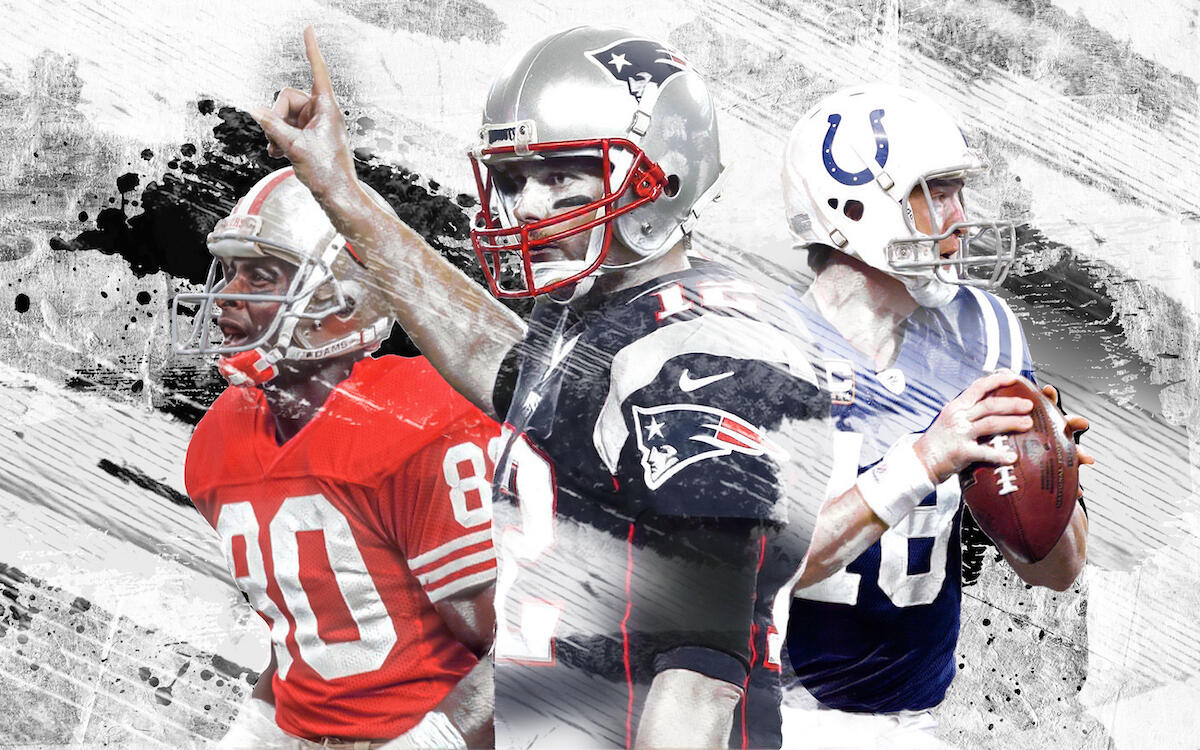It started with a book club and ended with the greatest to ever do agreeing to an unprecedented move

www.readoptional.com
Early in the college football season, a text popped up on my phone: “Have you read Rough Magic?”
It came from a former NFL coach who will soon be a part of Bill Belichick’s coaching staff at North Carolina — a real, actual sentence I just typed out without blacking out.
“Let me know what you think.”
On reflection, I don’t think they were asking me to review the prose.
Rough Magic is one of the
great forgotten football books, penned by Lowell Cohn in 1994 about Bill Walsh’s return to Stanford in the 90s. After a successful career as a college coach, Walsh became the architect of the Niners dynasty. A power struggle in San Francisco ultimately forced him out, and he “retired” to take up a gig in media. But talking about the game did not fill Walsh’s insatiable need to coach. Walsh, he said after he decided to return to the sideline, wasn’t fussed with winning. He just wanted to be on the grass. He wanted a whistle. He wanted to hear a crowd. He wanted to teach technique again, to mold a program – a program he loved – and prove to himself that he still had
it away from the glitz of Joe Montana, Jerry Rice, Steve Young, and the Niners.
I write this not to name-drop, though I have been asked a mind-numbing number of times on social media about where my info on Belichick moving to the college ranks came from. For those not on social media: I
first reported that Belichicks’s negotiations with UNC were legitimate, and not a ploy to conjure up interest from the NFL (everyone knew he was available; an interview with a middle-class college program was not going to frazzle NFL owners). I further
reported last Friday that a hitch in the negotiations revolved around the role of Stephen Belichick, his son, who is currently the defense coordinator at Washington. On Tuesday, I reported that
Belichick had agreed, in principle, to accept an offer from North Carolina if the school met strict stipulations, all featured in Belichick’s so-called “organizational bible” (we will get to that later). That’s right: Belichick agreed to a job he was not strictly offered. He didn’t want Mack Brown’s UNC job; he wanted a new job, one that would turn North Carolina into a
true football factory.
On Tuesday night, the two sides hashed out the parts of the deal they were stuck on – with North Carolina offering now-or-never terms. On Wednesday morning, Belichick accepted the agreement.
Now, the greatest pro football coach of his or any era is heading to college football — for the first time in his career. He is only the second Super Bowl-winning coach in history to head to college after lifting Lombardi, and the first to do so with
zero prior experience working in college.
I am no insider. I write about schemes. I scout. I coach. There is no need for me to protect sources. If I get interesting information from people in the pro or college game that can add further context to a
schematic discussion, I bring that stuff to my podcast with Jon Ledyard. That’s the extent of it. My next stroll into the Schefter game will probably come when Belichick decides to move on. But if you want to know where the information came from, and why it was reliable, then there you go.
I point out that text for one reason: these guys, Belichick and his clan of support staff, have been thinking about this for a
long time. This was not a spur-of-the-moment, only-job-on-the-market decision. Was the NFL the priority? Sure. But has college been a viable, interesting option for six months? Yes. Belichick and his staff have been doing their research for a year. Not only on the new college landscape, a wild west of pay-to-play, NiL deals, transfer portals and whatnot, but on the history of the game.
Belichick has spent his year out of the NFL drifting across college football. He’s popped up everywhere. But he’s also been active. He was not just a proud father swaggering around Washington in sweet Huskies gear this last season. He was helping his son, mapping out a practice roadmap through the offseason and preseason, and sending cutups and thoughts throughout the campaign to help Steve Belichick gameplan. Washington, for what it’s worth, jumped up from 50th in defensive SP+ last season to 28th in the nation this year under Belichick. Belichick Snr. also served as a sounding board to Huskies’ head coach Jeff Fisch on managing a roster.
The coach who sent that text was not interested in Cohn’s (outstanding) writing style. He wanted to bounce ideas around about an aging, legendary coach returning to the sidelines after a spell out of the NFL and working in media. Sound familiar?
What went wrong for Walsh at Stanford? What lessons are there?
Rough Magic is instructive. It shows a competitionaholic who is used to the very best — the best players, nutrition, coaching staff and scheme — coming to terms with what’s required at a lower level of the sport, and realizing that he is no longer up to it. Once you’ve reached a state of super genius (and Walsh was, by whatever definition you like, a super genius), can you unlearn what you know? Should you? Can you teach your sophisticated things to 18-year-olds, or do you have the imagination and willingness to implement fresh ideas? Can you relinquish control?
Walsh is the most impactful offensive coach of the modern era. Where others saw moving bodies, he saw a symphony. Football, he decided, was about rhythm. If you could tie the right progressions to the footwork of the quarterback, if you could have pre-defined reads that morphed based on the defensive shell, there should
always be an option to complete a pass. And if you can pair those designs with JOE MONTANA and JERRY BLEEPING RICE, it won’t just work, but you will win everything.
Walsh was one of those guys who didn’t need a framework. He painted on a blank canvas. He could picture it all — every possible iteration of the sport in his head — and fought with himself, constantly, about how to express those ideas and communicate them in a way that others, the mere mortals, could understand.
What Walsh was to the offensive side, Belichick has been to the defensive side of the ball. He was not
always a great innovator, but he was the best gameplan builder. Over two decades in New England, he was the finest defensive architect in the league, tracking the trends of the game and tying his scheme to his personnel.
Even at the very end, Belichick was up to stuff. He was iterating even as the Krafts had made the decision to dismiss him midway through his final season. And it should be noted that, though Belichick the GM wound up knee-capping Belichick the coach, New England finished last 8th in defensive EPA/play. After the team’s game against the Dolphins in Germany last year, when Robert Kraft decided to fire Belichick, they kept creeping up the defensive standings and finished 6th in EPA/play the rest of the way. At 71-years-old, that’s pretty damn good.
There are subtle distinctions between Belichick and Walsh: Walsh was more of a big-picture thinker, a creative. Offensive coaches typically are. They have to find fresh ways to break down long-held defensive structures. Belichick was (and is) different. He is obsessed with individual technique. While working with Nick Saban in Cleveland, Belichick was a furnace blast of ideas. That staff devised much of the defensive infrastructure (new, original ideas) that undergirds most of football at every level today. But during his New England days, Belichick would pinch things. Post-Cleveland, he was not always iterating defensive ideas but grabbing, installing, teaching and calling any idea he could find – and doing so better than anyone.
What is Gary Patterson’s third down plan? What’s that Saban blitz path? How is Vic Fangio manipulating these fronts? These read blitz things Nick installed in Miami, what if we run those over and over again? This new odd-mirror thing from Kirby, you know, I think we could use that against Lamar Jackson or Josh Allen.
That extended to the offensive side of the ball, too. He was a CEO in every way. From a power-based approach, to a rhythm-based passing game, to the bomb’s away years with Randy Moss, to embracing the spread revolution while other pro coaches cried heresy, to an up-tempo, two tight-end grouping that shelled the league in a way that people are still recovering from, on to ISO ball. And then, back again. One of the beauties of the latter stages of the Belichick-Tom Brady partnership was that they could call on things from any era they liked depending on the opponent. They had a Rolodex of designs and ways to attack defenses – individual coaches and individual players – that dwarfed everyone else.
Belichick’s genius came from his willingness to adapt. He hunted market efficiencies in his roster construction and echoed that in his schematic vision. Year-to-year, scheme-to-scheme, week-to-week, play-to-play Belichick’s Patriots would bounce between anything and everything — hitting on whatever they needed based on their personnel and gameplan. No front structure was off-limits. No coverage or blitz plan was too whacky. Some years they’d be heavy. In other years, he’d feature a big safety/dime linebacker at the highest rate in the league. He was constantly evolving, chasing new ideas from the best and brightest no matter if it came from high school, college, the pros or Canada. How about robbing an ineligible receiver play from
Lane Kiffin in the divisional round of the playoffs? I mean, please. The idea was all that mattered — and whether Belichick and his staff could teach it. Stubborn, competitive and controlling off the field? Sure. But within his scheme, he was never doctrinaire.
Anyone can take good ideas. Knowing when to deploy them — and how — is something else. What pushed Belichick into the upper echelon, though, was his ability to
teach everything. He did not sit behind his desk and install the gameplan, leaving the fussy bits to those beneath him. He was on the field teaching individual techniques to make sure every piece fit the jigsaw.
For Belichick, “Do Your Job” is not a catchy slogan. It has a real, tangible meaning:
I’ve put all this fucking effort into figuring out a plan you may not even be able to comprehend. Just run the technique I’ve taught you, don’t worry about everyone else, and, trust me, it will all come together. It’s why he is relentless about the details, and prioritizes the basics (tackling, leverage, playing to the team construct) over installing another quirky rotation.
The college game has evolved immeasurably since Walsh returned to Stanford. Colleges can effectively buy players — at least legally. The schematic bifurcation between the league and college is vast. College elements have infused the pro game, and they’re closer together than during the heyday of the spread-option revolution, but in terms of complexity and week-to-week gameplans, they’re still worlds apart.
A few years ago, college defenses had zoomed past the pro variations. Coaches had more time to work with their guys. They were not hauling in street-free agents to plug their hole at nickel. They could build amorphous, roaming, match-based coverages with players having spent multiple years in the program refining the basics. The truly great schematic thinkers and planners (Nick Saban, Kirby Smart, etc.) had the leg up of all those five-star recruits, but they were also able to install a series of complex, morphing coverages that even NFL sides can not slide into their plans regularly. The era of overloaded fronts, sim pressures, and creepers began with Rex Ryan but caught fire at the college level before working back up to the league as an every-down option.
Yet as college football becomes a year-to-year sport, with rampant transfers and squads assembled on a season-by-season basis, the playing field has evened out. Structurally, as on the offensive side of the ball, there is less on the menu of defenses these days. Does that give Belichick an advantage? Can
he install a level of complexity unseen elsewhere, or will his adaptability and focus on individual technique help raise North Carolina’s floor? Maybe? Possibly? Both?
If it’s the former, like Walsh, Belichick will have to deal with a key challenge: I’m a genius, sure, but how do I get across these ideas to 20-year-olds?

“It feels like I’m just along for the ride”
Walsh’s return to Stanford was miserable. He took over a program in the ascendency. In his first season, they finished 10-3. In his final two years, they went a combined 7-14-1.
Like Belichick, Walsh did not inherit a mess. The heavy lifting of raising Stanford from doormat to respectable was done by Dennis Green, who moved on to the Vikings after three seasons as Stanford boss, clearing the way for Walsh’s return.
The idea, as with Belichick at North Carolina, was to build on a baseline of success.
Maybe the genius can drag us another rung up the ladder. But Walsh grew frustrated that teenagers could not crack his complex system. In the pros, Walsh experienced burnout. Back in college, he became ill.
The Stanford team Walsh inherited was built on the backs of Green’s physically imposing defense. In Walsh’s first season, that defense suffocated folks as his offense stumbled around. Walsh brought Fred Von Appen with him, a long-time confidant who bounced around the league and served three separate stints as Stanford’s DC. Von Appen was so loyal to his coach that Walsh was able to talk him out of taking a job in the NFL to patrol the sidelines in Palo Alto. But in that opening season, with the defense on fire and Walsh’s offense hitting a wall, the program was effectively split in two: A defense built by Green and run by Von Appen and Walsh’s pesky offense. One was talented, the other dire.
It gnawed at Walsh. “I feel like I’m just along for the ride,” Walsh said.
Walsh was old and tired. He had little time for the extra-curriculars of being a college czar. He just wanted to coach ball. And even that was a challenge. Walsh routinely fell asleep at his desk. In team meetings, Steven Stenstrom, his quarterback, had to point out that he had mislabeled the blocking mechanics on specific plays. “You’re right,” Walsh said. “I don’t know what I was thinking.”
Before a game against San Jose, Walsh had incorrectly drawn up several plays on the team’s opening drive. After he was made aware, he went to his office, beat himself up, corrected the issues, and spent another sleepless night in his 60s at his desk.
That’s the danger of an aging coach. Their mind may willing, but it’s not always able. Here, Belichick differs, slightly. His authoritative approach belies the fact that he is, at heart, a collaborator. He just wants the final sign-off.
Walsh’s staff was also filled with in-fighting. It was a group divided between has-beens and want-to-bes. Walsh saw his return not as a way to pump up his own resume, but to be a legitimate
school – only a football one. He wanted to get guys to the pros (sound familiar) but also give a first crack to some of his former players who wanted to coach. It left him with an inexperienced staff that was in over their heads, and the head coach lacked the vigor to paper over issues on his own. Even the loyal lieutenants started to think the old boss had lost his magic. As word leaked out that coaches were talking behind his back, Walsh lit up his staff room: “I want to remind you that you’re a well-paid staff. You work fewer hours than most college coaches, and you live in a beautiful part of the world.”
The whole experience showed a coach unable to effectively translate his ideas anymore — at least to a different generation.

“I get gloomy sometimes,” Walsh said. “And they don’t know what it means. Each coach assumes I’m thinking about him. Of course, sometimes I am.”
After a grueling defeat to Arizona, Walsh became increasingly ill. He had brought some of his former Niner stars to the game, hoping the stardust of Joe Montana and Dwight Clark would rub off on his players and potential recruits. But he absorbed another bitter loss, and it exposed the differences between the college game and the pros. In the NFL he could stew, and beat himself up. Back in college, he had to get to work. Sat at his chair after the defeat, staring into space, he whispered: “now I have to go to a cocktail party”. He stayed for ten minutes, leaving before the guests arrived.
So frustrated after the Arizona loss — the team was “lower than whale shit,” according to Von Appen — Walsh walked out of the next day’s film review. Cycling through plays, he stood up, hit the exit and went to eat a sundae. It was the last day of his career that he ran through his initial review of the tape with his coaching staff present.
How does an older coach balance the fact that they know what’s required to win at the highest level while fighting the pull of time? When it gets tough, do they lock in, review their process, adjust their approach, or do they run for ice cream?
By the middle of his first season, Walsh had already started to break his non-negotiables, and the aftershocks would ripple through his two losing seasons. He “re-assigned” staff members in the middle of the season (a kind way of saying they were fired), and took on more of the day-to-day burden. But even that thinking was muddled; Walsh would try to be involved, but he lacked the energy to take on too many duties.
“At 60, I just don’t have the vitality to go over and be a line coach,” Walsh told a friend. “I just want to be the head coach.”
He also started to verbally attack his players in team meetings:
“I’m really sick of this offensive line. I’m disgusted… At the beginning of the season of the season, I said you were the strength of this ball club. You’re the weakness. We can’t throw the ball. You’re getting the quarterback's eyes knocked out. I’m totally frustrated with this unit, and it wasn’t just them — it was a sorry offensive effort. We don’t want to finish the season thinking it was the offense that let us down.”
It’s a telling portrait. Walsh, an intellectual, always believed there was a correct solution to a problem. He just had to think about it long enough. He didn’t resort to barking at players. If something had gone wrong, it was on
him. But read that last sentence again: “We don’t want to finish the season thinking it was the offense that let us down.”
This is a man battling with a legacy. He knows how unusual/bizarre/madcap it is that the NFL’s greatest innovator is back in school. If the offense falls to pieces, it’s a reflection on him, on his standing in the game (at least in his mind) than it is on the players.
Maybe that whole San Francisco thing was about Montana and Rice and Young and Clark after all.
He did not return to college to buffer his legacy but found himself battling ghosts anyway.
Walsh was famed in San Francisco for teeing off on his staff rather than players during meetings. The implication was that the staff flowed through him; so any criticism of a position coach was
really a critique of himself. He would give coaches a heads-up, letting them know he was trying to get a message across without making it personal with the time.
At Stanford, that cracked. Walsh crushed his team and staff members, without telling them what was coming. “I don’t know, maybe you were told to do it,” Walsh told a lineman after highlighting another blown protection, singling out his offensive line coach.
Walsh broke the confidence of his own staff. During meetings toward the back half of his first season, Walsh became physically sick.
Walsh was away from coaching for three years. Because of the time that had lapsed, the little things, the details, were missing as soon as he walked through the door at Stanford. He bundled staffing assignments, struggling to figure out how to divvy up who was responsible for which elements of practice. He only realized his error once he saw the product on the field midway through his first season. He compounded the error by bouncing back and forth between being too hands-on and too hands-off, with the staff unclear on any given day what fresh responsibilities the boss was taking on board. He was a genius chasing his tail.
“I didn’t feel I was in control as I should have been,” Walsh said.
In the interest of transparency, that is one of the notes I sent back after reading the book: “If you’re going to do it, do it. Two years out is two too many.”
Towards the end of his first season, Walsh would dash off paranoid letters to alums who criticized him, reminding them that he had won three Super Bowls and overseen the model for a professional franchise forever more.
And that’s why, though it remains a shocker, it’s not
completely stunning to me that Belichick leaped at the first college job that came calling. His thinking about what is required is clear — and North Carolina was aligned with the vision.
Belichick is a less emotive coach than Walsh, less prone to outbursts. But he also spent the majority of his career inoculated in a bubble of his own creation. At the end in New England, he took out his frustration with the Kraft family on loyal coaches. Jerod Mayo and Bill O’Brien were drafted in by the Krafts to wrestle some control away from their all-powerful football monarch. O’Brien was a Belichick guy. But for two weeks during his final season in New England, Belichick did not speak to his offensive coordinator. After being pushed on Belichick in the offseason, O’Brien was now viewed as a Kraft guy.
How will it go when Belichick has to answer the phone lines to local Carolina callers, a tried and true way for a college coach to burnish support? What if the team loses three in a row and they question his defense or quarterback decision? Will he spit back something about his eight Super Bowl rings? Will he note that he helped develop Lawrence Taylor and Dont’a Hightower and coached Darrelle Revis to his lone Super Bowl? Can you hear it now?
Yeah, what do I know, I only coached Tom fucking Brady.
Even as someone who had worked at the college level before, at the same damn school, Walsh struggled to return to the amateur ranks. He had been pro-football-itized. The ass-kissing and hand-shakes-for-cash that fuel the college football economy, and help to build the roster, was seen as beneath him. He cut privileges to the locker room, even to the team chaplin. “If you’re not on the team, you can’t come in the locker room,” Walsh said.
Belichick will face similar issues. But he’s walking into a different college landscape.


















































